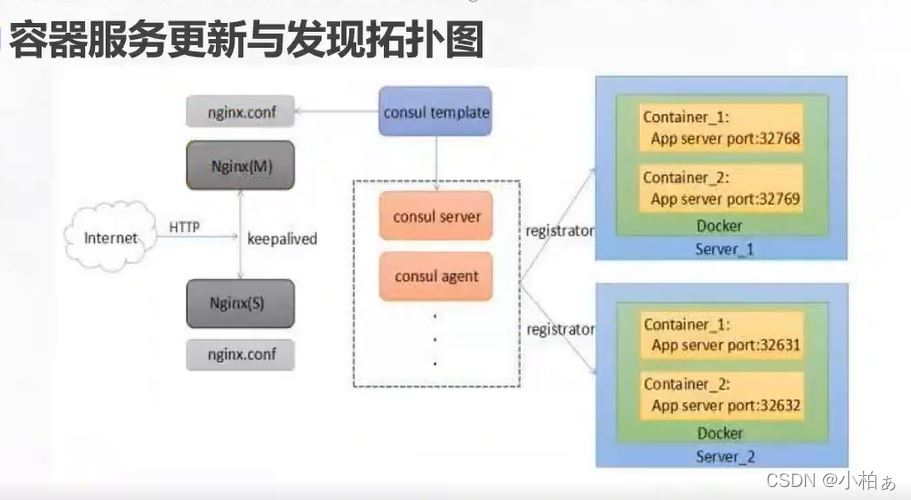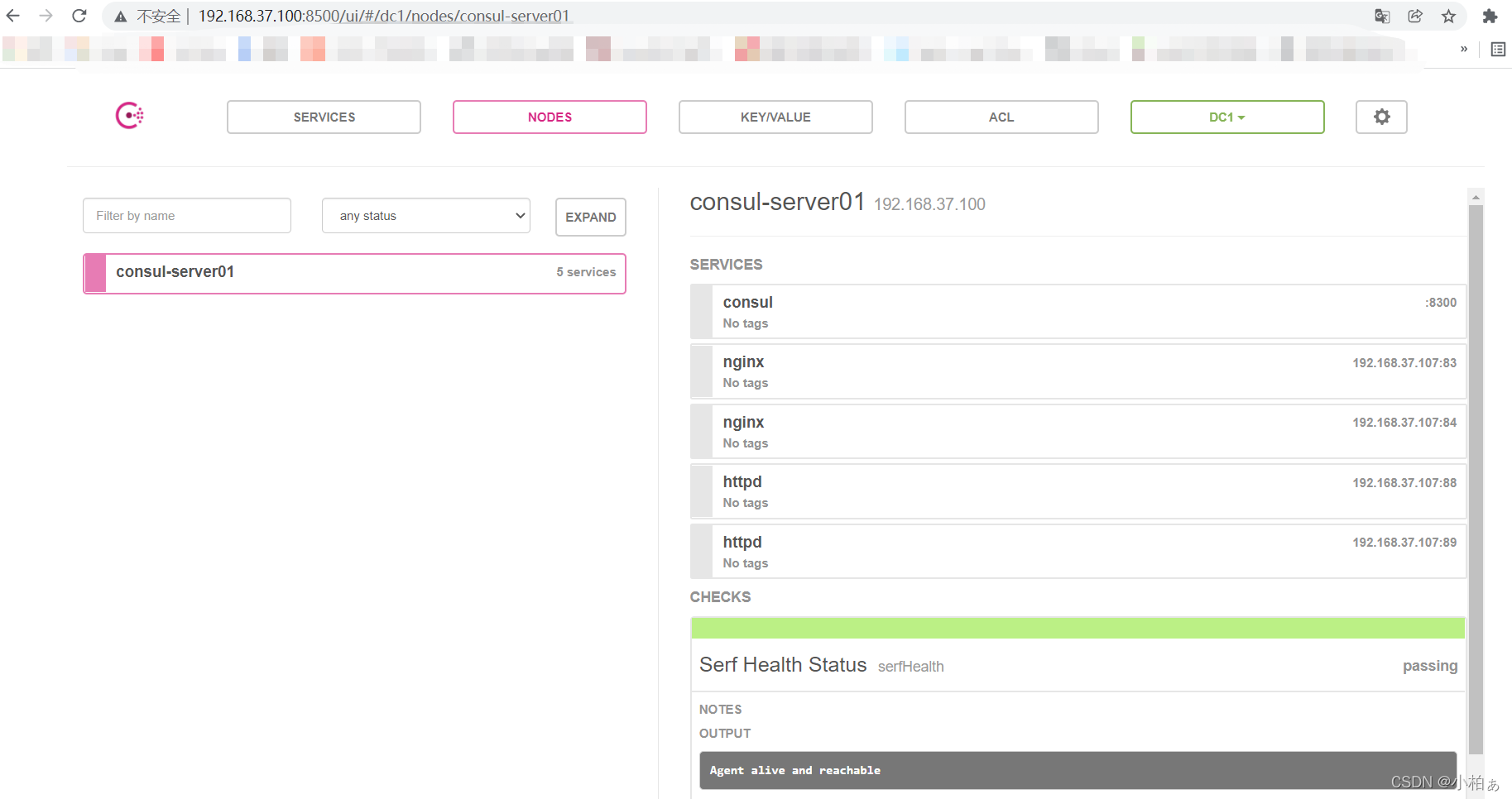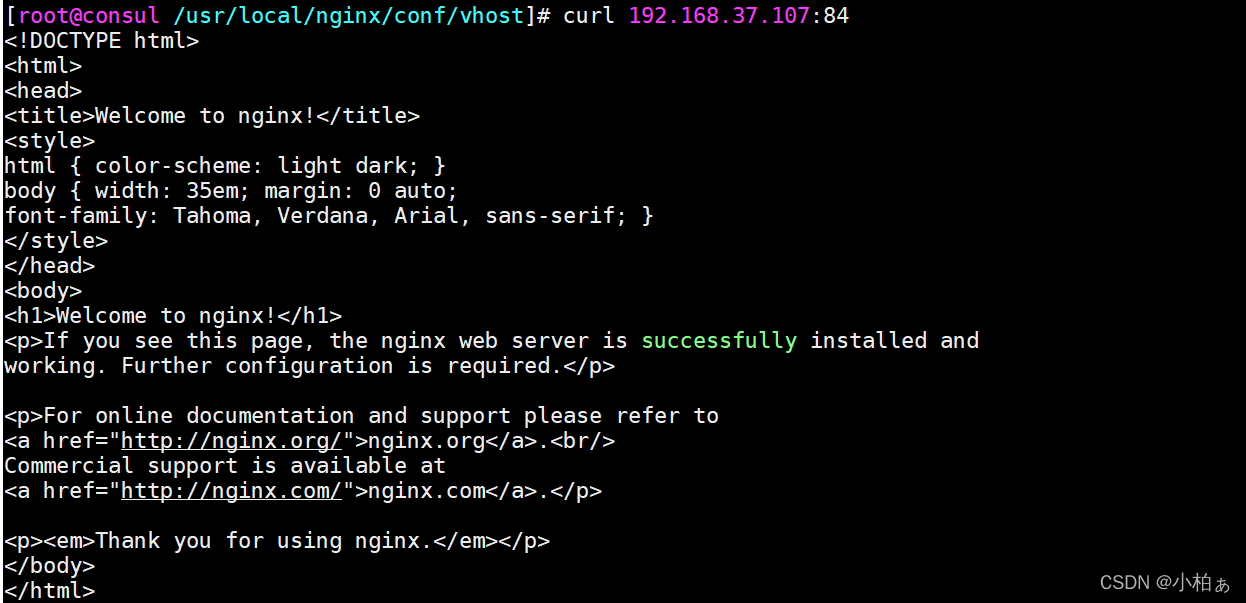Docker容器如何部署consul
小编给大家分享一下Docker容器如何部署consul,相信大部分人都还不怎么了解,因此分享这篇文章给大家参考一下,希望大家阅读完这篇文章后大有收获,下面让我们一起去了解一下吧!
Consul简介
Consul 是一个支持多数据中心分布式高可用的 服务发现 和 配置共享 的服务软件,由 HashiCorp 公司用 Go 语言开发, 基于 Mozilla Public License 2.0 的协议进行开源。 Consul 支持 健康检查,并允许 HTTP 、GRPC 和 DNS 协议调用 API 存储键值对.
命令行超级好用的虚拟机管理软件 vgrant 也是 HashiCorp 公司开发的产品.
一致性协议采用 Raft 算法,用来保证服务的高可用. 使用 GOSSIP 协议管理成员和广播消息, 并且支持 ACL 访问控制.
Consul 使用场景
Docker 实例的注册与配置共享
Coreos 实例的注册与配置共享
SaaS 应用的配置共享、服务发现和健康检查。
vitess 集群
与 confd 服务集成,动态生成 nginx 和 haproxy 配置文件
-consul部署-

服务器:192.168.37.100 Docker-ce、Consul、Consul-template
服务器:192.168.37.107 Docker-ce、registrator
template模板(更新配置文件)
registrator(自动发现+注册到consul-server端)
后端每更新出一个容器,会向registrator进行注册,控制consul完成更新操作,consul会触发consultemplate模板进行热更新(reload)
核心机制: consul :自动发现、自动更新,为容器提供服务(添加、删除、生命周期)—------consul服务器
创建consul目录
[root@localhost ~]# hostnamectl set-hostname consul[root@localhost ~]# su[root@consul ~]# mkdir /root/consul将consul压缩包压缩并放到/use/bin下
[root@consul ~]# cd consul/[root@consul ~/consul]# lsconsul_0.9.2_linux_amd64.zip[root@consul ~/consul]# unzip consul_0.9.2_linux_amd64.zipArchive: consul_0.9.2_linux_amd64.zip inflating: consul[root@consul ~/consul]# lsconsul consul_0.9.2_linux_amd64.zip[root@consul ~/consul]# mv consul /usr/bin/配置consul的模式
onsul agent \
-server \ server模式
-bootstrap 前端框架
-ui \ 可被访问的web界面
-data-dir=/var/lib/consul-data \
-bind=192.168.37.100 \
-client=0.0.0.0 \ registrator(应用服务器-docker-tomcat/apache)
-node=consul-server01 &> /var/ log / consul.log &
[root@consul ~/consul]# consul agent \> -server \> -bootstrap \> -ui \> -data-dir=/var/lib/consul-data \> -bind=192.168.37.100 \> -client=0.0.0.0 \> -node=consul-server01 &> /var/log/consul.log &[1] 24144[root@consul ~/consul]# consul membersNode Address Status Type Build Protocol DCconsul-server01 192.168.37.100:8301 alive server 0.9.2 2 dc1此时我们看群集信息
[root@consul ~/consul]# consul membersNode Address Status Type Build Protocol DCconsul-server01 192.168.37.100:8301 alive server 0.9.2 2 dc1查看详细信息,过滤出leader
[root@consul ~/consul]# consul info | grep leader leader = true leader_addr = 192.168.37.100:8300查看consul界面。使用8500端口,8300是通信端口

容器服务自动加入consul集群
安装Gliderlabs/Registrator Gliderlabs/Registrator
可检查容器运行状态自动注册,还可注册docker容器的服务信息到服务配置中心(consul 8300 -----》8500展示)。目前支持Consul、Etcd和skyDNS2。
在192.168.37.107执行以下操作
[root@server ~]# docker run -d \> --name=registrator \> --net=host \> -v /var/run/docker.sock:/tmp/docker.sock \> --restart=always \> gliderlabs/registrator:latest \> -ip=192.168.37.107 \> consul://192.168.37.100:8500 ###下面的是加载Unable to find image 'gliderlabs/registrator:latest' locallylatest: Pulling from gliderlabs/registratorImage docker.io/gliderlabs/registrator:latest uses outdated schema1 manifest format. Please upgrade to a sc hema2 image for better future compatibility. More information at https://docs.docker.com/registry/spec/depr ecated-schema-v1/c87f684ee1c2: Pull completea0559c0b3676: Pull completea28552c49839: Pull completeDigest: sha256:6e708681dd52e28f4f39d048ac75376c9a762c44b3d75b2824173f8364e52c10Status: Downloaded newer image for gliderlabs/registrator:latest2536df1b1fbb77dcbf5d2e09295f222496ecc63f00a49020ce6976decd52a439查看容器
[root@server ~]# docker ps -aCONTAINER ID IMAGE COMMAND CREATED STATUS PORTS NAMES2536df1b1fbb gliderlabs/registrator:latest "/bin/registrator -i…" 51 seconds ago Up 50 seconds registrator测试服务发现功能是否正常
安装两个nginx和2个apache
docker run -itd -p:83:80 --name test-01 -h test01 nginxdocker run -itd -p:84:80 --name test-02 -h testo2 nginxdocker run -itd -p:88:80 --name test-03 -h test03 httpddocker run -itd -p:89:80 --name test-04 -h test04 httpd
此时去网页查看

安装consul-template
Consul-Template 是一个守护进程,用于实时查询consul集群信息,并更新文件系统上任意数量的指定模板,生成配置文件。更新完成以后,可以选择运行shell命令执行更新操作,重新加载Nginx。Consul-Template可以查询consul中的服务目录、Key、 Key-values 等。
这种强大的抽象功能和查询语言模板可以使Consul-Template 特别适合动态的创建配置文件。例如:创建 Apache/Nginx (nginx upstream) Proxy Balancers、Haproxy Backends
准备template nginx模板文件
--------------------------------------------------在consul上操作----------------------------------------------------
[root@consul ~/consul]# vim nginx.ctmp1upstream http_backend { {{range service "nginx"}} server {{.Address}}:{{.Port}}; {{end}}}server { listen 83; server_name localhost 192.168.37.100; access_log /var/log/nginx/xiao.cn-access.log; index index.html index.php; location / { proxy_set_header HOST $host; proxy_set_header x-Real-IP $remote_addr; proxy_set_header client-IP $remote_addr ; proxy_set_header x-Forwarded-For $proxy_add_x_forwarded_for; proxy_pass http://http_backend; }安装nginx
####安装所需软件包[root@server ~]# yum install gcc pcre-devel zlib-devel -y###解压nginx软件包[root@server ~]# tar zxf nginx-1.12.0.tar.gz###执行[root@server /opt/nginx-1.12.0]# ./configure --prefix=/usr/local/nginx##编译[root@server /opt/nginx-1.12.0]# make && make install修改配置文件,让其识别.conf文件结尾的文件

创建vhost目录
[root@server /usr/local/nginx/conf]# mkdir vhost创建nginx日志目录
[root@server /usr/local/nginx/conf/vhost]# mkdir /var/log/nginx.log启动nginx
[root@server /usr/local/sbin]# ln -s /usr/local/nginx/sbin/nginx /usr/local/sbin/[root@server /usr/local/sbin]# nginx查看是否启动
[root@server /usr/local/sbin]# netstat -natp |grep nginxtcp 0 0 0.0.0.0:80 0.0.0.0:* LISTEN 54739/nginx: master配置并启动template
[root@consul ~/consul]# unzip consul-template_0.19.3_linux_amd64.zipArchive: consul-template_0.19.3_linux_amd64.zip inflating: consul-template[root@consul ~/consul]# lsconsul_0.9.2_linux_amd64.zip consul-template consul-template_0.19.3_linux_amd64.zip nginx.ctmp1[root@consul ~/consul]# mv consul-template /usr/bin##关联nginx虚拟目录中的子配置文件操作
[root@consul ~/consul]# consul-template -consul-addr 192.168.37.100:8500 \> -template "/root/consul/nginx.ctmp1:/usr/local/nginx/conf/vhost/xiao.conf:/usr/local/nginx/sbin/nginx -s reload" \> --log-level=info查看生成配置文件

是都可以访问。

以上是“Docker容器如何部署consul”这篇文章的所有内容,感谢各位的阅读!相信大家都有了一定的了解,希望分享的内容对大家有所帮助,如果还想学习更多知识,欢迎关注编程网行业资讯频道!
免责声明:
① 本站未注明“稿件来源”的信息均来自网络整理。其文字、图片和音视频稿件的所属权归原作者所有。本站收集整理出于非商业性的教育和科研之目的,并不意味着本站赞同其观点或证实其内容的真实性。仅作为临时的测试数据,供内部测试之用。本站并未授权任何人以任何方式主动获取本站任何信息。
② 本站未注明“稿件来源”的临时测试数据将在测试完成后最终做删除处理。有问题或投稿请发送至: 邮箱/279061341@qq.com QQ/279061341
















